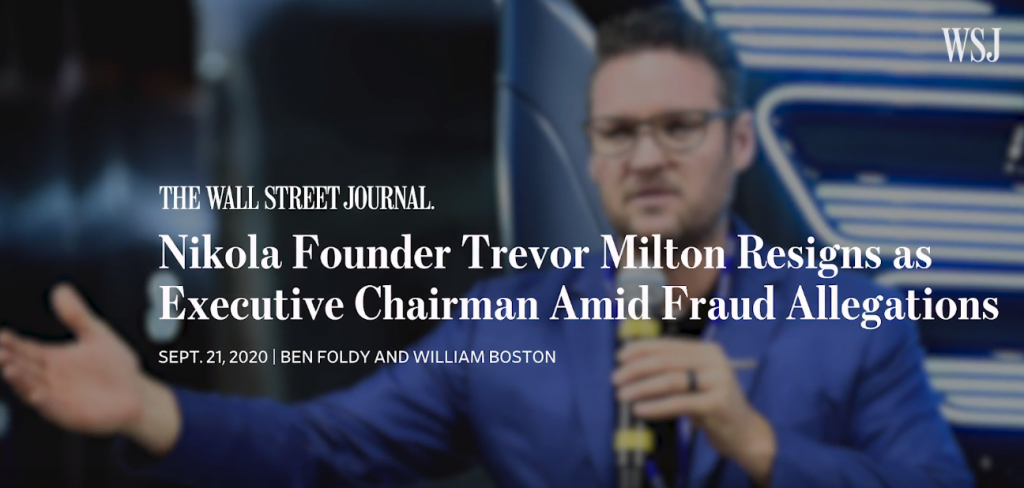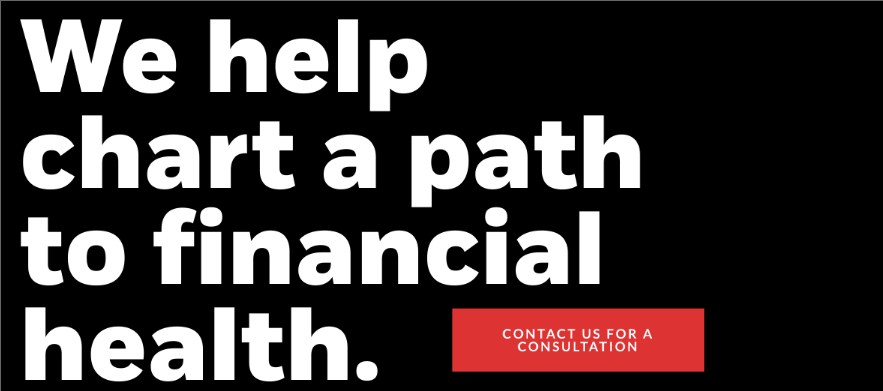What is a SPAC and why are some private tech companies choosing it as a way to go public on wall street?
If you watch business news channels such as Bloomberg or CNBC, You may have heard the term SPAC recently referred to in investor, financial or other news headlines. CNBC reported in January that back in September of 2019, when former unicorn coworking space startup WeWork set out to go public in its IPO imploded as its business model and co-founder Adam Neumann’s management came under intense scrutiny. Now, the office space leasing start-up is in talks to go public via a different way: It’s considering using a SPAC, or special purpose acquisition company, one of the hottest trends on Wall Street in the past year.
WeWork’s announcement is just the latest in a growing list of companies: Virgin Galactic, DraftKings, Opendoor and Nikola Motor Co. have all gone public by merging with SPACs. An article in Toptal reported that in fact more than 248 special purpose acquisition companies (SPACs) went public in 2020, raising about $75.3 billion, more funding than in all the previous years since 2010 combined, according to University of Florida professor and IPO expert Jay Ritter.
CNBC also reported that SPACs lined up for 2021, include Bill Gates-backed portable ultrasound start-up Butterfly Network (valuing the company at $1.5 billion) and DNA-testing startup 23andMe is reportedly in talks to go public through a $4 billion deal. There is also buzz that digital media companies like BuzzFeed, Vice Media, Bustle Media Group and others could use SPACs to finally bring in money for their investors. Or the activist investor Bill Ackman’s Universal Music SPAC deal.
So what exactly is a SPAC? What would make some companies pick a SPAC over a traditional IPO or direct listing? And why are investors lining up to jump on the trend?
What’s a SPAC?
The CNBC article describes it as “a special purpose acquisitions company is essentially a shell company set up by investors with the sole purpose of raising money through an IPO to eventually acquire another company.”
And a PWC article goes on to further explain that these special purpose acquisition companies (SPACs), also called a “blank check” company, have become a preferred way for many experienced management teams and sponsors to take companies public. A SPAC raises capital through an initial public offering (IPO) for the purpose of acquiring an existing operating company. Subsequently, an operating company can merge with (or be acquired by) the publicly traded SPAC and become a listed company in lieu of executing its own IPO.
Companies typically pursue an initial public offering to raise capital, provide shareholder liquidity, create brand awareness and obtain resources to further expand their business. Increasingly, companies across all sectors are considering mergers with special purpose acquisition companies (also known as SPACs), rather than a traditional IPO, to achieve these goals. PWC thinks that this trend will likely continue as a growing number of major private equity (PE) firms, venture funds and operators form more SPACs. Last year I wrote an article about the differences between Direct Listings vs Traditional IPOs, venture funded startups who are looking to go public.
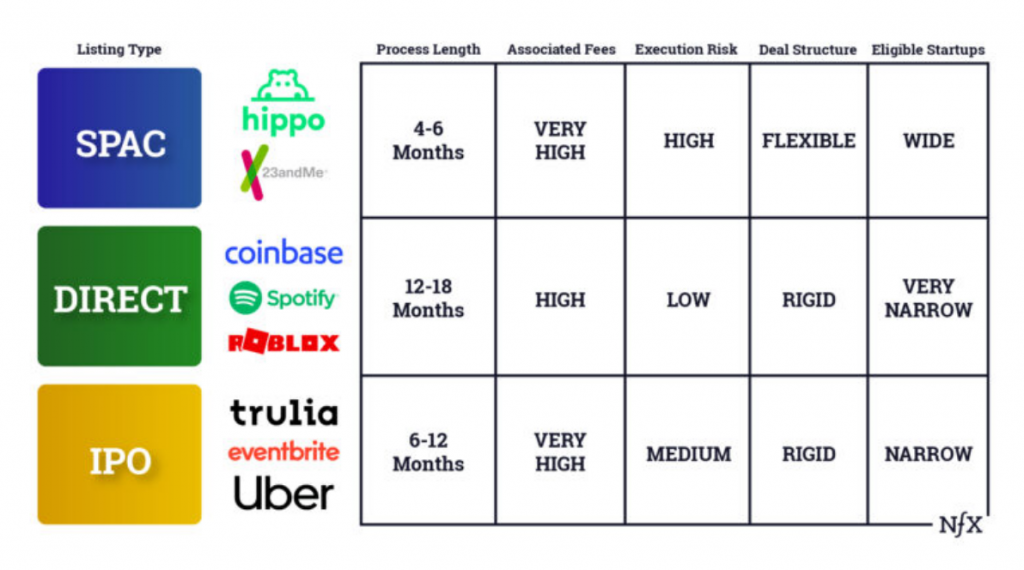 (image credit: NFX)
(image credit: NFX)
Lise Buyer, a known IPO advisor told the NFX podcast about the history of SPACs
“Historically, it was companies that probably couldn’t get public the regular Traditional IPO way. Maybe they were in gambling. All the cannabis companies went public via SPAC. Where there was some legitimate fear that they wouldn’t be able to get public any other way. Over the past year, that has changed a little bit.”
Basically SPACs are “blank check” companies designed solely to raise capital through an IPO in order to merge with private companies. By merging with a SPAC sponsor, firms can access liquidity via the public market. As an example, last year in August of 2020, a driverless car startup Luminar Technologies announced it would go public via a $3.4 billion merger with the SPAC, Gores Metropoulos Inc. SPACs can be an effective tool for institutional investors and private equity firms to participate in acquiring private companies with potential.
According to Business Insider, SPACs offer individual investors the chance to get in on the ground floor of a potentially big stock, but are also highly risky.
What is driving the SPAC boom?
According to the Toptal article, there are a few factors and parties in SPAC transactions that are propelling the popularity of this trend:
- Retail investors – are tired of watching tech IPOs spike more than 40% in their first few days of trading. As small investors, they’re unable to participate in traditional IPOs. SPACs offer retail investors a shot at investing in a fast-growing, young company.
- Supply and demand – the number of public companies has gone down dramatically over the last 20-30 years, dropping from 8,000 to just over 4,000 today, but the amount of money flowing into the public markets has simultaneously been increasing. Because the stock exchanges make their money by bringing on new companies, they’ve pushed to bring more SPACs into the market.
- SPAC sponsors – (the management team that sources the deal) get a blank check with unlimited upside and minimal downside if the deal doesn’t materialize (and a deal almost always materializes). Sponsors contribute a minimum of at-risk capital and often end up holding a 20% or larger stake; this is known as the “promote.” The rationale for the promote is they are the ones putting the deal together.
- Private companies – can get to market faster—in months versus a traditional IPO, which can take more than a year—and unburden themselves of the risks of timing the IPO window. Also, the underwriter fees are slightly lower, as some of the heavy lifting has already been done by the SPAC when it went public.
- SEC regulations – the SEC has become more involved in regulating SPACs, which has proven to boost their reputation in the investment world. They have stepped in to set a fixed price for each IPO, as well as regulate voting and redemption rights to the benefit of all parties involved.
Improved reputation since SPACs were first created in the 1990s
But according to PWC, they didn’t gain much popularity with blue-chip investors until the past few years. Back in 1993, the first SPA was created by David Nussbaum. a time when blank check companies were prohibited in the US. And during the 1990s, SPACs had a shady reputation known for scamming investors. Since then, SPACs have adopted some investor protection measures, like allowing investors to back out if they don’t approve of the merger. The increase in investor protection, combined with more VCs frustrated with the traditional IPO process, led to some serious names becoming SPAC sponsors. In October 2019, Virgin Galactic led the way when it merged with VC Chamath Palihapitiya’s SPAC. This was the first time that a company that Wall Street considered legitimate went public via SPAC.
In 2019, the number of SPACs as a share of IPOs rose to 30% from 4% in 2013, according to PwC’s analysis of Dealogic data. The surge comes as more blue-chip private equity firms, banks and high-profile entrepreneurs are forming SPACs, which in turn, has further attracted owners of private companies interested in going public. For instance, the latest wave of SPACs involve Pershing Square Capital Management, Goldman Sachs and TPG Capital, among other major investment groups. Why are they popular? Because despite the economic ups and downs of the Covid-19 pandemic over the last 15 months, SPACs have become a viable liquidity option. Since then many success stories have followed, among them DraftKings, which IPO-ed via SPAC and has returned 776% as of March 2021.
By going public under a SPAC, private companies can benefit in the following ways:
Get more access to capital
Small and mid-sized companies may want to continue to fund development, invest in brand awareness or make acquisitions to continue growing, but they may not be ideal candidates for traditional IPOs. By merging with a SPAC sponsor, existing companies can retain a stake in their business and gain access to liquidity that otherwise would not be available to them.
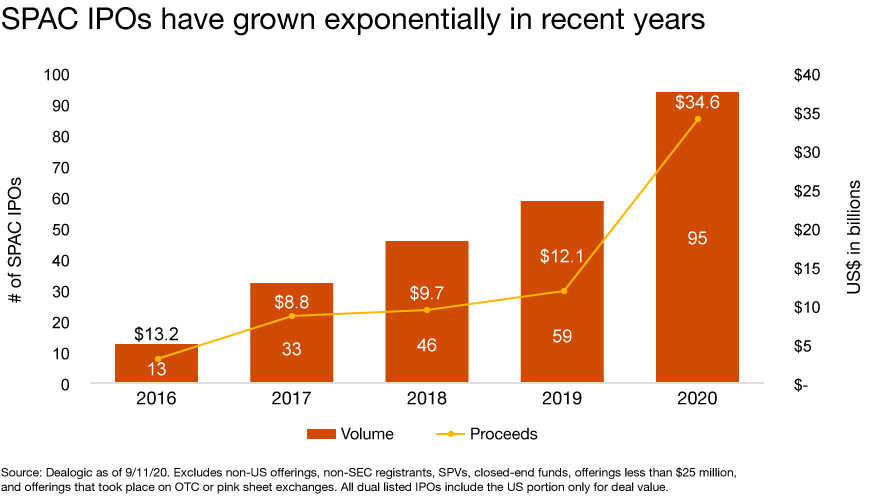 (image credit:PWC)
(image credit:PWC)
Greater market certainty
With US stocks becoming volatile, finding the right window to debut on Wall Street can be tricky and costly. If a company is too conservative and prices it’s offering too low, the company risks “leaving money at the table.” Also, the price of the stock may suffer simply because the market was down the day the company goes public.
With SPAC mergers, there’s less uncertainty. Unlike traditional IPOs, target companies can negotiate the price of their stock with the SPAC sponsor as part of their merger agreement. In other words, targets can lock in a price; therefore, helping shield its value from market uncertainty.
Faster time to market than a traditional IPO
A SPAC transaction is a merger; it can be a reverse merger, a merger of equals, or SPAC owners can dominate the cap table post transaction. Yet, because the SPAC was prepared, filed, and managed for the purposes of executing a merger, it is likely faster (and cheaper) than a traditional IPO for the acquired company. “The typical IPO process can take one to two years from start to finish, while a SPAC merger only takes three to four months.” said – Aleksey N. Krylov, CFA
More flexible deal terms
Besides negotiating valuation, SPACs also present target companies the flexibility to negotiate other terms of the deal that work in their favor. This could include structuring the transaction to bring in additional dollars through a private investment in public equity (PIPE), as well as add additional debt or equity. Further, a target’s board of directors is subject to negotiation.
For target companies considering a SPAC, having the right expertise will be important for negotiating the most optimal deal terms.
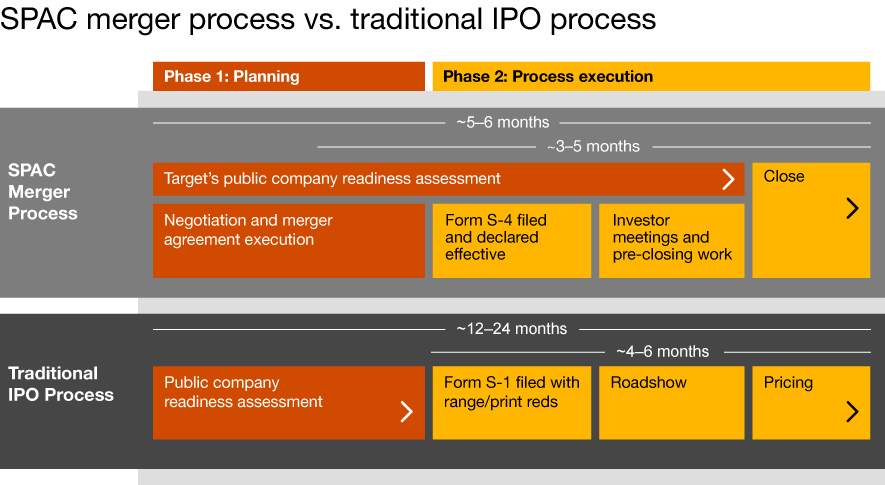
(image credit:PWC)
Not all SPACs are the same in regards to quality
According to analysis from PWC, for a private company, choosing the right SPAC sponsor will be very important because unlike a traditional merger deal where the buyer and seller seek out business synergies, a company looking to merge with a SPAC needs to agree with the sponsor’s long-term business goals.
For example, a startup focused on electric vehicles should seek out SPAC sponsors backed by investors focused on that space and who will understand that area. This is especially important because a key goal of a SPAC transaction is to ensure the target has adequate capital to be successful following the merger. Since investors in a SPAC have the right to redeem or pull out of their investment at closing, it’s critical that the target and sponsor agree on the long-term prospects of the business.
The SPAC merger process
Once formed, the SPAC will typically need to solicit shareholder approval for a merger and will prepare and file a proxy statement (or a joint registration and proxy statement on Form S-4 if it intends to register new securities as part of the merger). This document will contain various matters seeking shareholder approval, including a description of the proposed merger and governance matters. It will also include a host of financial information of the target company, such as historical financial statements, management’s discussion and analysis (MD&A), and pro forma financial statements showing the effect of the merger.
Analysis from the PWC article explains that once shareholders approve the SPAC merger and all regulatory matters have been cleared, the merger will close and the target company becomes a public entity. A Form 8-K, with information equivalent to what would be required in a Form 10 filing of the target company (commonly referred to as the Super 8-K), must be filed with the US Securities and Exchange Commission (SEC) within four business days of closing.
Some accounting and reporting considerations
- Public company readiness – a target company in a SPAC merger will need to prepare itself for being a public company normally within a few months, which is a shorter timeline compared to a traditional IPO for substantially the same preparation, due diligence, prospectus-drafting and SEC engagement and oversight. Public company readiness for a target company should cover cross-functional topics such as: accounting and financial reporting, finance effectiveness, financial planning and analysis, tax matters, internal controls and internal audit, human resources (HR) and compensation, treasury, enterprise risk management, technology and cybersecurity.
- Tax structuring – A SPAC merger normally requires multiple steps of legal / equity restructuring that impacts the tax status and considerations of the target company.
- Financial Statements – the target company’s financial statements must be in compliance with SEC reporting requirements. Financial statement disclosure areas with substantial uplift, including earnings per share, segments, adoption of new standards, as well as quarterization, among others, can increase the time and effort required to prepare compliant financial statements.
- Form 8K – a Form 8-K with equivalent information that would be required in a Form 10 filing of the target company (commonly referred to as the ‘Super’ 8-K) must be filed with the SEC within four business days of closing.
There are some disadvantages and risks associated with SPACS
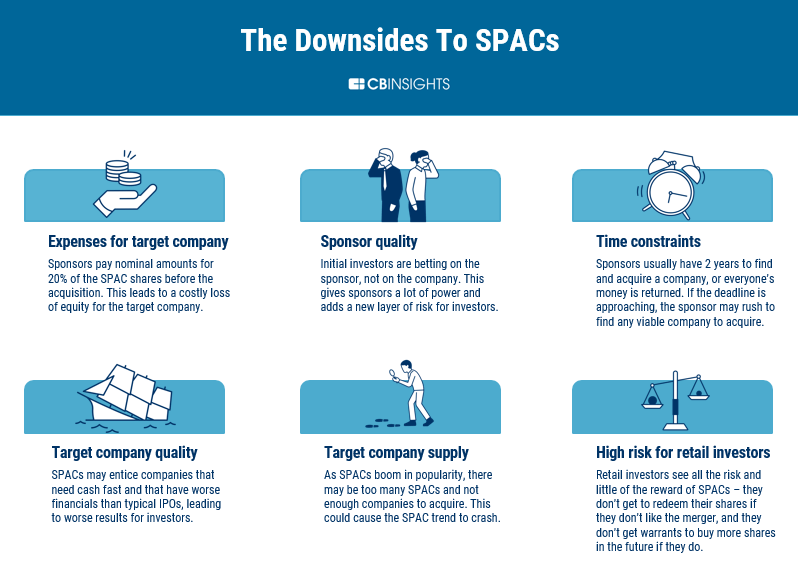 (image credit: CB Insights)
(image credit: CB Insights)
As this article in CB Insights points out, Despite the positives, there are also challenges and concerns regarding the structure of the SPAC method. From sponsor risk to low-quality companies to supply & demand concerns, SPACs are far from perfect. Even the SPAC king Chamath pinned an OP-ED in Bloomberg that laid out that more regulation and oversight are needed.
- Blind investment – SPAC investors usually don’t know how their money will be used — what the SPAC’s target company is (often the sponsors don’t know either). So the deal’s impossible to evaluate.
- Mixed track record – last year in a July 2020 report, Goldman Sachs analyzed the performance of 56 SPACs — primarily in the technology, industrials, energy, and financial segments — that “merged” with their target companies beginning in January 2018. “During the one-month and three-month periods following the acquisition announcement, the average SPAC outperformed the S&P 500 by 1 percentage point (pp) and 11 pp, respectively, and beat the Russell 2000 by 6 pp and 15 pp, respectively,” the report notes. “However, the average SPAC underperformed both indexes during the 3, 6, and 12-months after the merger completion.”
- Quality of the target companies – or a struggling company, a SPAC may provide a temporary lifeline that’s faster to access than the public markets. One study showed that, between 2003 and 2013, 58% of companies that merged with SPACs failed — a higher rate than traditional IPOs. Even if companies don’t fail outright, some negative press may have an outsized impact on the SPAC reputation for companies considering this process in the future. For example, electric truck company Nikola went public via SPAC in March 2020, despite not earning any revenue in 2019 and lacking a clearly viable truck model. It saw its market cap jump to $29B — higher than Ford’s — before its CEO resigned and the SEC opened an investigation into the company for fraud. Stories like this could taint the reputation of SPACs in the future, potentially pushing other companies away from the structure.
- Lack of readiness for compliance & regulatory requirements – once a company is public, it has to operate as such, in compliance with regulatory requirements. This includes publishing of financial reports and disclosures periodically, conducting shareholder meetings, or working within strict governance and financial controls frameworks imposed by the securities laws and enforced by the SEC and exchanges (e.g., Nasdaq). Furthermore, unlike an IPO, in which management teams have the luxury of doing trial runs and making mistakes while the company is preparing for the IPO, managers don’t have that luxury. Mistakes can be costly and have long-lasting ramifications. Sponsors should start prepping early, operating as a public company while it’s still private.
- High risk for retail investors – retail investors get all of the risk — and limited rewards — associated with SPACs. If retail investors buy into the SPAC but are unhappy with the announced target company, there is little recourse besides selling their shares. And unlike institutional investors, which get warrants to buy more shares after the target company is announced as an incentive for purchasing shares in a SPAC, retail investors do not enjoy that benefit, limiting their potential upside.
Conclusion
The IPO expert Lise Buyer commented on whether this is a new bubble waiting to happen? “Will it be something to go away in the next 2-5 years? I think the SPAC frenzy is going to take a bit of a powder here while people figure out what the new regulations are, what the liabilities are.” SPACs are speculative investment bets. They tend to acquire growth companies — start-ups and fledgling firms — which, by their nature, are higher-risk than, say, established blue-chip companies.
Still, SPACs offer smaller investors a way to get into the IPO game — if not up front with the big players, at least not too far behind them. From a startup founder’s perspective, Ms. Buyer suggests – do not agree to merge with a SPAC unless:
- You like the valuation.
- You think they can justify the valuation.
- And you believe that the sponsor of the SPAC will truly be there to help you.
Regardless whether a private company decides to SPAC, direct list, or do a traditional IPO, it is recommended that they have an experienced CFO or IPO adviser on board, to help get ready to operate as public company such as upgrading systems, putting in the effort that needs to go into closing the quarter, improving your numbers etc.


